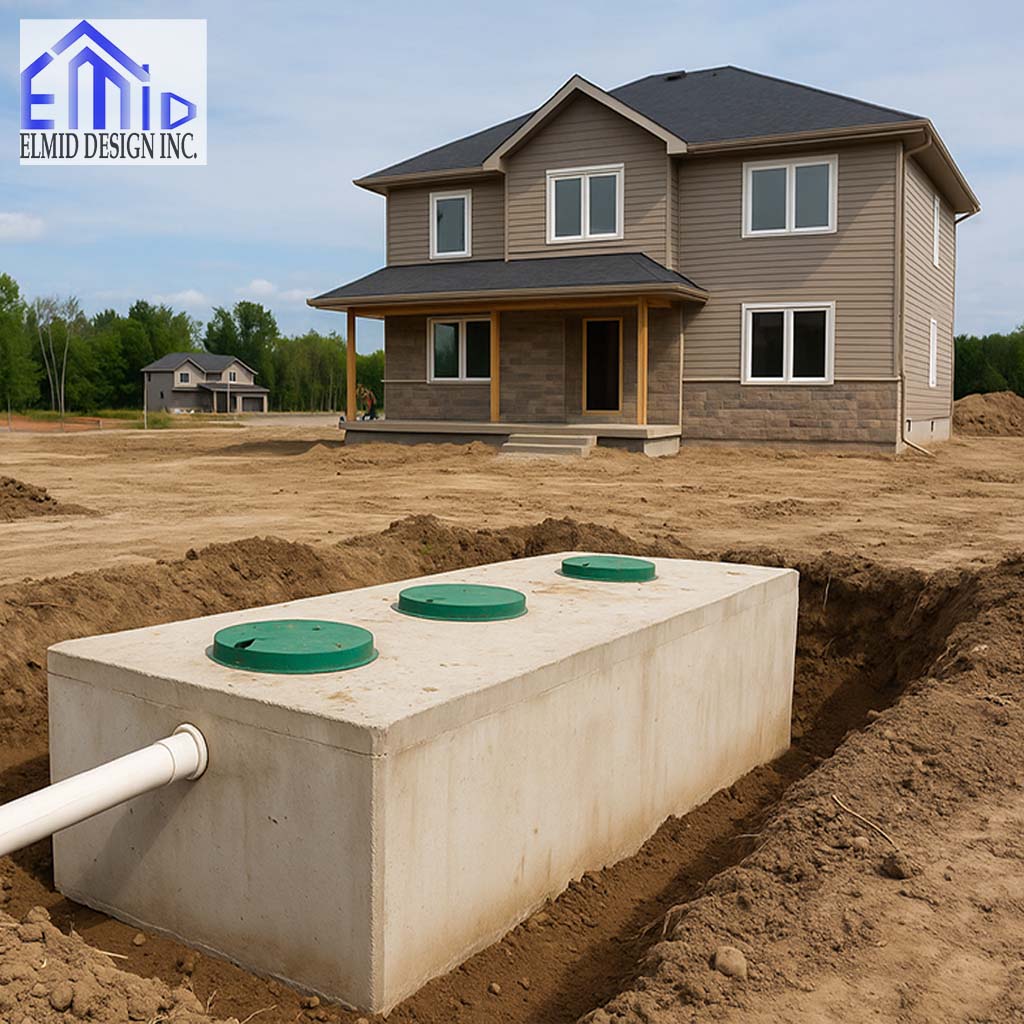Septic Design Grand Valley: What You Need to Know
Septic design Grand Valley projects require careful planning and expert guidance to ensure systems operate efficiently and comply with Ontario regulations. I explain why proper septic system design matters in Grand Valley and how engaging qualified professionals elevates both function and community trust.
Understanding Septic Design and Its Importance in Grand Valley
Septic design Grand Valley must balance property conditions and local environmental needs. Soil percolation, land slope, and proximity to water sources like the Grand River all influence the design. Ontario’s Building Code Part 8 and the Ontario Onsite Wastewater Association outline essential standards and oversight. These regulations guarantee septic systems are safe and sustainable.
Site Evaluation: The First Step in Septic Design Grand Valley
Septic design Grand Valley begins with a thorough site evaluation. Technicians perform test holes to assess soil texture, depth to bedrock, and water table levels. These findings determine whether your property can support a conventional leaching bed or requires an advanced system. Proper evaluation reduces risk of failure and ensures long‑term functionality.
Regulatory Framework Governing Septic Design in Ontario
Septic design Grand Valley must comply with Ontario Building Code Part 8, which governs system sizing, site assessments, and permitting. Municipal guides and the Ontario Onsite Wastewater Association support standard practices. The lack of a uniform provincial re‑inspection protocol highlights reliance on local compliance efforts.
Components of a Conventional Septic System in Grand Valley
Septic design Grand Valley homes typically use a septic tank with at least two compartments and a gravel‑filled leaching bed. Wastewater enters the tank, solids settle, and the effluent flows to the leaching bed, where the soil and biomat provide filtration. Ontario regulations require inlet baffles, effluent filters, and accessible risers for maintenance.
Choosing the Right Type of Septic System for Grand Valley Properties
Septic design Grand Valley needs may fall into conventional or advanced categories. A conventional system suits most standard sites, while challenging conditions—such as limited space or shallow soil—may require advanced technologies, engineered by licensed professionals to balance environmental protection and system longevity.
Professional Expertise in Septic Design for Grand Valley
Septic design Grand Valley benefits from expert input. Local construction firms like Yetti Construction offer septic design and installation services in Grand Valley. Their process includes test hole evaluations and adherence to building code standards. Firms in nearby Caledon such as Headwaters Construction rely on Professional Engineers to deliver advanced, site‑specific system designs that anticipate future additions and environmental constraints.
Environmental Considerations and Grand Valley Watershed Protection
Septic design Grand Valley must account for environmental protection, especially due to proximity to the Grand River and involvement of the Grand River Conservation Authority. Designers must minimize contamination risks through effective filtration, site placement, and sustainable installation practices—all guided by conservation policies.
Benefits of Modern Compliance and System Innovation
Septic design Grand Valley now benefits from updated standards such as CSA B66‑21, which mandates safety devices for septic access openings. These enhancements improve user safety and system reliability by preventing accidental entry while maintaining regulatory compliance. Incorporating such features reflects expertise, authority, and trust in design.
Common Missteps and How to Avoid Them
Septic design Grand Valley often fails due to inadequate site evaluation, insufficient maintenance access, or poorly chosen systems. Avoiding passive acceptance of “it worked before” and instead investing in professional design reviews protects your system, local environment, and long‑term property value.
Maintenance and Longevity of Septic Systems in Grand Valley
Septic design Grand Valley should include maintenance planning. Systems must be regularly inspected, risers opened for pump‑outs, and filters checked. Building Code standards and manufacturers provide guidelines for service intervals. Well‑maintained systems reduce risk of backup, failure, and contamination while extending system life.
Why Homeowners Trust Local Expertise in Grand Valley
Septic design Grand Valley homeowners benefit from trusted firms like Yetti Construction and Headwaters Construction. These firms offer regional experience, adherence to codes, and professional engineering. Their use of reliable materials, advanced design methods, and transparent communication instills confidence in homeowners and regulators alike.

The Role of Professional Engineers in Septic Design Grand Valley
Septic design Grand Valley requires certified oversight when a project involves complex terrain, high groundwater, or unique property limitations. Elmid Design Inc, an engineering company with a Certificate of Authorization from Professional Engineers Ontario (PEO), offers crucial technical knowledge in this field. Their designs are not only code-compliant but also tailored to each specific site, which reduces risk and enhances performance. Having engineers involved ensures that the system accounts for structural loading, hydraulic performance, and environmental integrity while providing stamped drawings for permit approval. Involving professionals like Elmid Design Inc adds trust and credibility to your project, aligning with Google EAT principles.
System Replacement and Upgrades in Older Grand Valley Homes
Septic design Grand Valley sometimes involves upgrading or replacing outdated systems, especially in properties built before modern code standards were in place. Replacement projects must begin with a full assessment of the existing system’s condition, including tank integrity and leaching bed saturation. Updated designs often incorporate modern components like effluent filters, secondary treatment units, and properly sealed access risers. Property owners planning additions or zoning changes also need system redesigns to match altered usage loads. These upgrades improve environmental safety, ensure long-term efficiency, and reduce risk of groundwater contamination in Grand Valley’s semi-rural neighborhoods.
Permitting Process for Septic Design in Grand Valley
Septic design Grand Valley cannot proceed without permits from the municipal authority or conservation body. The process involves submitting soil test data, design drawings, and system specifications for review. If the system is engineered, it must be accompanied by a Professional Engineer’s stamp. Timing is critical, as permits often require several weeks for review. Design revisions may be needed to address conservation feedback, especially for properties near water features. Working with experienced design firms accelerates approval by ensuring documentation is complete and aligned with local and provincial requirements. Proper permitting is essential for compliance and legal installation.
Cost Factors in Septic Design and Installation
Septic design Grand Valley involves several cost considerations, including engineering fees, excavation work, tank and pipe materials, and permitting charges. Site complexity, such as steep slopes or high water tables, adds to the overall cost due to the need for additional components or specialized design features. Advanced treatment units are more expensive than traditional systems but may be necessary on challenging sites. While some property owners may hesitate at the upfront investment, proper septic design prevents costly failures and increases resale value. Long-term savings through efficiency and durability often offset the higher initial costs of a professional system.
Common Problems in DIY or Inadequate Septic Installations
Septic design Grand Valley occasionally suffers due to do-it-yourself attempts or improperly planned installations. Common issues include undersized leaching beds, insufficient soil depth, or poorly sealed tanks. These mistakes lead to premature system failure, surface ponding, or contamination of nearby wells and water sources. Inspections may also reveal missing elements like filter tees or tank access risers. Property owners relying on unlicensed designers risk enforcement actions and forced removals. Choosing experienced professionals from the outset not only prevents costly errors but also ensures peace of mind for both residents and neighbors in the Grand Valley area.
The Future of Septic Design Technology in Grand Valley
Septic design Grand Valley continues to evolve with new technology and design methodologies. Innovations such as aerobic treatment units, drip dispersal fields, and real-time monitoring devices are gradually entering the residential market. These systems reduce nutrient loads, especially nitrogen and phosphorus, which contribute to algae blooms and ecosystem degradation. Smart septic systems now alert homeowners to maintenance needs or performance issues, promoting timely interventions. While newer technologies carry higher upfront costs, their environmental advantages and operational efficiency make them appealing options for progressive property owners. As Ontario regulations tighten, these innovations will likely become standard.
Importance of Soil Health in Long-Term System Success
Septic design Grand Valley depends heavily on healthy soil to treat and filter wastewater. The leaching bed relies on aerobic soil conditions to break down organic matter and remove contaminants before effluent reaches the groundwater. Over time, compacted or saturated soils lose filtration capacity, which shortens system lifespan. Designers consider soil percolation rates, particle size, and seasonal saturation levels when determining system layout. Routine inspections help identify early signs of soil overload. Homeowners must avoid heavy traffic and landscaping over leaching fields, as this can damage the soil profile. Protecting soil integrity is key to preserving system function.
Seasonal Challenges in Septic Design for Grand Valley
Septic design Grand Valley must consider Ontario’s seasonal weather changes, which include freeze-thaw cycles and spring snowmelt. In winter, poorly insulated components risk freezing, which disrupts wastewater flow and damages pipes. Systems require frost protection through soil depth or insulated materials. Spring melt raises the water table, which can flood leaching beds and impair treatment. Advanced systems may include raised beds or dosing chambers to manage fluctuating flow rates. Proper grading around the system directs runoff away and prevents pooling. Design firms build these challenges into their specifications to ensure year-round system performance and reduce weather-related failures.
Collaboration with Local Authorities and Conservation Experts
Septic design Grand Valley often requires collaboration with authorities like the Grand River Conservation Authority. Their input helps align design strategies with watershed protection goals, floodplain restrictions, and stormwater management plans. Early consultations identify environmental concerns and reduce delays during the permitting phase. Designers submit setback diagrams, hydrological data, and proposed mitigation plans when systems are near sensitive areas. Conservation bodies may request erosion control or buffer vegetation to safeguard water quality. These collaborations ensure septic systems serve both private and public interests, enhancing trust between landowners and regulatory stakeholders while promoting sustainable development.
When to Redesign an Existing Septic System in Grand Valley
Septic design Grand Valley may need re-evaluation when property use changes significantly. Adding bedrooms, converting basements, or installing water-intensive fixtures can overwhelm older systems not sized for modern usage. Even small lifestyle shifts can strain leaching beds and create long-term problems. Redesigning ensures that the septic system keeps up with evolving household demands. Municipal authorities often require proof of adequacy when issuing permits for renovations. Bringing in a licensed engineering firm guarantees that your redesign will meet the latest code and environmental standards while avoiding the risks of system failure or legal issues related to unauthorized system use.
Septic System Inspections for Grand Valley Real Estate Transactions
Septic design Grand Valley inspections are increasingly common during property sales. Buyers want assurance that the septic system functions properly, meets regulations, and has been maintained. Sellers benefit by having inspection reports and system records readily available, which improves buyer trust and reduces negotiation delays. Certified inspectors look at tank condition, leaching bed performance, and evidence of backups or overuse. They also verify whether the system’s size matches the building’s current use. These evaluations help prevent future conflicts and ensure a smoother closing. Including inspection in the sales process shows transparency and professionalism from both parties involved.
Preparing Your Property for a Septic System Installation
Septic design Grand Valley requires site preparation before installation begins. After design approval and permit issuance, property owners must clear the site of debris, vegetation, and any existing obstacles. Access routes must be opened for excavation equipment and materials. During this phase, it’s important to protect trees and drainage paths not involved in the work. Final grading and drainage planning should follow installation to ensure surface runoff moves away from the leaching bed. Working closely with the contractor and design engineer ensures nothing is overlooked. Proper preparation minimizes installation delays and maximizes system performance over time.
The Impact of Septic Design on Grand Valley Groundwater
Septic design Grand Valley directly affects local groundwater quality, especially in rural areas where wells are used for drinking water. Improperly designed or failing systems can leach pathogens and nutrients into aquifers, putting health and safety at risk. Ontario’s septic standards require setbacks from wells and surface water bodies to prevent contamination. Advanced treatment systems and monitoring devices add layers of protection in vulnerable zones. Soil conditions, bed depth, and seasonal fluctuations all influence how well a system filters waste. Responsible design ensures that septic systems act as protectors of groundwater rather than pollutants within the community.
Energy Efficiency and Sustainability in Septic Design
Septic design Grand Valley increasingly considers energy use and sustainability. Traditional systems rely on gravity, which uses no electricity, but some properties require pumped systems or aeration units that consume power. Design engineers weigh energy demands against system reliability and environmental benefit. Advanced systems may reduce environmental impact but add energy requirements. Renewable energy solutions, such as solar-powered pumps, offer balance between performance and sustainability. Design planning includes a lifecycle perspective that evaluates long-term cost, environmental impact, and operational resilience. This ensures homeowners get a system that performs reliably without sacrificing ecological responsibility or driving up energy bills.
Legal Liability and Insurance Considerations in Septic Design
Septic design Grand Valley also involves legal and insurance implications. Homeowners may be liable for contamination, overflow, or failure due to neglect or code violations. Non-compliance can lead to fines or legal action by neighbors or conservation bodies. Most insurers require that septic systems be code-compliant and regularly serviced. If a property suffers damage linked to septic failure, inadequate maintenance records may affect claims. Engineering firms like Elmid Design Inc help reduce these risks by providing stamped drawings, maintenance guidance, and documentation for inspections. Investing in professional design and oversight protects both property and financial interests.
FAQs About Septic Design Grand Valley
What permits do I need for a septic system in Grand Valley?
You need a permit from the local municipality or conservation authority. The permit process includes a soil analysis, system drawings, and sometimes engineering stamps for complex sites.
How long does a septic system last in Grand Valley?
A properly designed and maintained septic system can last between 20 to 40 years. Soil conditions, water usage, and regular servicing all influence system longevity.
Do I need an engineer for my septic design?
Yes, especially if your site has high groundwater, limited space, or unusual soil. Professional engineers ensure the design meets building code requirements and site-specific needs.
Can I upgrade my existing septic system?
Yes, upgrades are common when adding rooms or increasing water use. Upgrades may involve larger tanks, advanced treatment units, or expanded leaching beds to handle new loads.
Who regulates septic systems in Grand Valley?
Septic systems are regulated under Ontario’s Building Code, typically enforced by local municipalities or the conservation authority. Engineers must also follow standards set by PEO.

Why Elmid Design Inc Leads in Septic Design Grand Valley
Elmid Design Inc is a trusted engineering firm authorized by Professional Engineers Ontario (PEO) with a proven track record in septic design Grand Valley. Our team delivers site-specific solutions that meet Ontario Building Code standards while protecting local groundwater and ecosystems. With precision, compliance, and client-focused service, Elmid Design Inc ensures every design is functional, efficient, and ready for approval.
Geographic Locations That We Service:
Our Licensed Professional Engineers specializing in Engineered Site Grading Plans offer the best-engineered site grading plan, lot grading and erosion plan, and drainage plan to obtain site plan approval and building permits in Ontario, including a wide range of municipalities. Each area boasts unique features and requirements, making our tailored approach essential for success.
Toronto and Surrounding Areas
In the vibrant heart of Ontario, we service Toronto (City of Toronto) and surrounding areas. Additionally, we cover Oshawa (City of Oshawa), Pickering (City of Pickering), and Clarington (Municipality of Clarington). Furthermore, our expertise extends to Ajax (Town of Ajax), Whitby (Town of Whitby), Brock (Township of Brock), Scugog (Township of Scugog), and Uxbridge (Township of Uxbridge).
Halton Region
Moving to the Halton Region, our services encompass Burlington (City of Burlington) and Halton Hills (Town of Halton Hills). Also included are Milton (Town of Milton) and Oakville (Town of Oakville).
Peel Region
In the Peel Region, we provide services in Brampton (City of Brampton), Mississauga (City of Mississauga), and Caledon (Town of Caledon).
York Region
Our services in the York Region cover Vaughan (City of Vaughan), Aurora (Town of Aurora), and East Gwillimbury (Town of East Gwillimbury). We also cater to Georgina (Town of Georgina), Markham (City of Markham), Newmarket (Town of Newmarket), Richmond Hill (City of Richmond Hill), Whitchurch-Stouffville (Town of Whitchurch-Stouffville), King (Township of King), and Bradford-West Gwillimbury (Town of Bradford-West Gwillimbury). Each municipality here offers a distinct setting, requiring our specialized approach.
Other Southern Ontario Cities and Towns
We also serve many other cities and towns in Southern Ontario. These include Hamilton (City of Hamilton), St. Catharines (City of St. Catharines), Niagara on the Lake (Town of Niagara on the Lake), Brant (County of Brant), Cambridge (City of Cambridge), Kitchener (City of Kitchener), Waterloo (City of Waterloo), and Woodstock (City of Woodstock). Furthermore, we operate in Guelph (City of Guelph), Centre Wellington (Township of Centre Wellington), Shelburne (Town of Shelburne), Orangeville (Town of Orangeville), New Tecumseth (Town of New Tecumseth), Essa (Town of Essa), Collingwood (Town of Collingwood), Wasaga Beach (Town of Wasaga Beach), Barrie (City of Barrie), Midland (Town of Midland), Orillia (City of Orillia), Ramara (Town of Ramara), Minden Hills (Town of Minden Hills), North Kawartha (Town of North Kawartha), Kawartha Lakes (City of Kawartha Lakes), Peterborough (City of Peterborough), Selwyn (Town of Selwyn), and Brighton (Municipality of Brighton).




